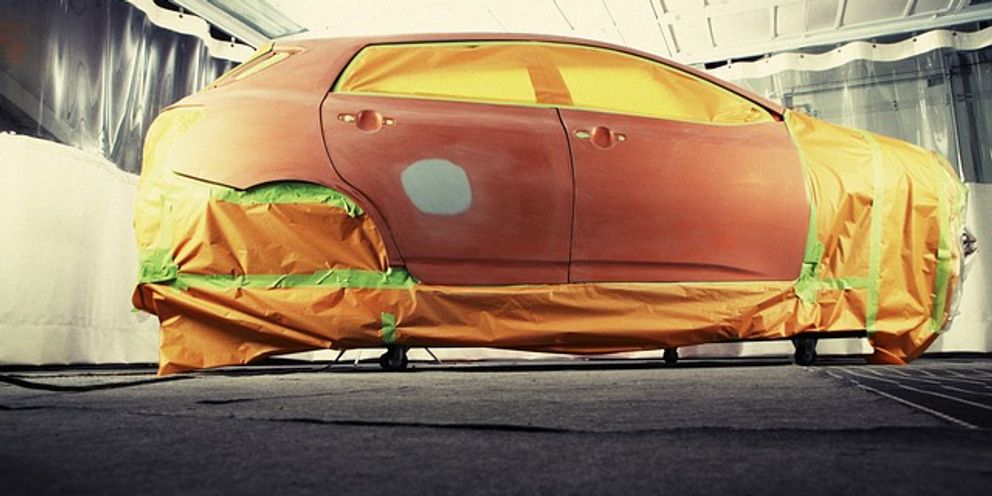
Covering Your Car with New Coats of Paint
By John Linden
One of the most important steps in creating an eye-catching, envy-inducing ride is selecting the right car covering color. The average driver may not realize it, but there's a lot more to a car's paint job than just the color. There's also the type of paint coat used. These four coats—solid, metallic, pearlescent, and matte—have their pros and cons. Let's take a look at each of these and the reasons you'd want to cover your car with them.
Solid Paint
When you buy a car off the lot, it is usually covered with a basic, solid, non-metallic paint unless you pay extra for a special color. Most cars painted with solid paint are done in one of four primary colors: white, black, red, and blue. The paint is applied in one single layer, then sealed with a clear lacquer to help protect it from chips and scratches. Many manufacturers have started using a mixture of paint and a hardening agent that turns the paint into a type of glue, removing the need for sealant. Most cars will get scratched at some point, which is why some people use a car cover to provide additional protection.
Pros of solid paint:
- It is cheap.
- Small chips can be repaired easily using a touch-up pen.
- It is quick and easy to use.
Cons:
- Paint tends to start to show discoloration upon close inspection.
- Color choices to cover your car choices can be limited.
Solid Car Paint Colors – More on the benefits of solid paint.
9 Ways to Ruin your Paint – How can you accidentally damage your car’s paint cover?
How to Care for your Car’s Paint – A guide from cars.com.
Metallic Paint
Metallic paints are very similar to solid paints, but they have a little bit of a special powdered metal mixed in. This powder is a type of aluminum and is mixed in at about a ratio of 1:50. However, some manufacturers use different metals or add more or less. While many manufacturers charge a good amount to upgrade your car’s paint job from solid to a metallic cover, the actual cost of the paint itself is not that much higher for a small car. However, multiple coats of both the paint and the sealant are needed to cover your car properly.
Pros of metallic paint:
- The metallic particles catch and reflect light, making the car shine.
- Metallic paint tends to hide minor damage better than a solid paint cover.
Cons:
- It is harder to a match metallic paint cover, making it more challenging and costly to repair.
- If not polished properly, it is far easier to see the swirl marks on your paint cover.
7 Pros and Cons of Metallic Car Paint – More on the benefits of solid paint.
Metallic Powders – How can you accidentally damage your car’s paint cover?
History of Metallic Paints – A guide from cars.com.
Pearlescent Paint
Pearlescent Paint is similar to metallic paint except instead of having metal particles mixed in; it uses ceramic crystals. These crystals reflect and refract light, making the paint cover for your car sparkle and appear to look different from various angles and lighting conditions. Also like metallic paints, pearlescent car cover paints have to be applied in several coats rather than the quick, single coat of a solid paint cover. Because of the cost of this paint, car owners will want to do everything possible to prevent scratches, such as covering their car during inclement weather.
Pros of pearlescent paint:
- Looks amazing in any light.
- Can hide some damage.
Cons:
- Very expensive—pearlescent paint covers can be four to five times the cost of metallic.
- Like metallic coats, it can be hard to match if the paint cover is damaged.
Metallic vs. Pearlescent - Which one is better?
Pearlescent Coating - More information on this type of coating for covering your car.
11 Crazy Auto Body Paint jobs - You will not believe some of these car cover jobs.
Matte Paint
Matte paint is fairly uncommon, but some manufacturers use it to make their niche vehicles stand out. Usually, matte vehicles are covered in black or grey. These cars are not reflective or shiny, a look that is achieved by using a solid paint cover that has been mixed with a high amount of PVC or epoxy. The clear coat can also have a flattening agent added to it to get a matte finish. This look, which can sometimes end up looking more like a silk or satin finish, is often used on older restored vehicles, although some high-end luxury cars have made use of it for covering.
Pros of matte paint:
- It looks different than other paint covers, making your vehicle stand out.
Cons:
- It is the most expensive type of paint available.
- Repairing and maintaining matte paint jobs can be tough, which is why you'll want to protect your car with a car cover at all times.
Matte vs. Glossy - While it discusses bicycle paints, much is also applicable to cars.
How You Should Tend to Matte Paint – A care guide for matte car cover paints.
Hyundai’s Matte Paint Guide – A guide for caring for matte paint by the manufacturer.
Conclusion
Whether you go with a standard solid paint, want to make your car stand out with a metallic or pearlescent car cover coat, or go all out and have a matte finish done, it is important to pick the right type of paint. It is more than just the color—with different pros and cons, selecting the right type of paint will determine how easy it is to repair any scratches and whether or not you need to invest in a good custom car cover.
Updated